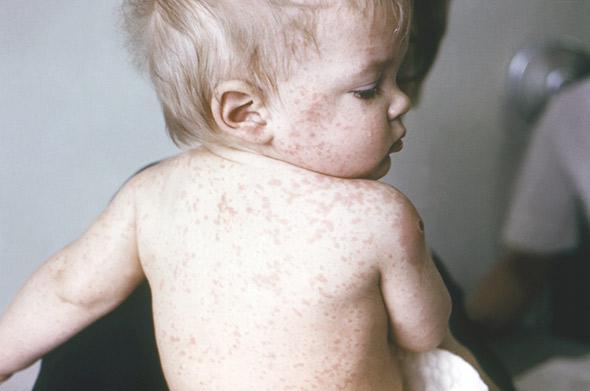A measles outbreak has sickened at least 19 people in New York City. Many of the victims are children who were either too young to be vaccinated or whose parents chose not to vaccinate them. A few of the patients, however, had at least one documented dose of the measles-mumps-rubella vaccine. If you’ve had the MMR vaccine, should you be worried?
Probably not. If you’re old enough to read this article, you should have had two doses of MMR vaccine. Most people receive the first dose just after their first birthday. The single shot confers immunity to measles in more than 95 percent of recipients. You should have received a second dose around the age of 4. (Older readers may not have received the second shot until later in life; the recommendation for the double dose wasn’t made until the 1990s.) The two-dose regimen confers lifelong immunity to the overwhelming majority of people.
A small number of vaccinated people, however, never manufacture measles antibodies, for reasons that are poorly understood. This is called primary vaccine failure. There is also a very low rate of secondary vaccine failure: A person who initially demonstrates immunity loses it later in life. Herd immunity to measles should protect people who experience either kind of failure, but falling vaccination rates have allowed measles to circulate and can leave people without sufficient antibodies vulnerable. If you’re unsure whether you’ve received both doses of the MMR vaccine, or if you are worried about your immune status, your doctor can measure your antibodies against measles.
Falling vaccination rates are now an urgent concern in public health. Measles incidence dropped 99 percent after the vaccine was introduced in 1963. Between 2000 and 2007, the United States saw an average of just 63 measles cases per year, and almost all of those victims brought the disease into the United States from abroad. In 2013, however, the incidence of measles tripled. Unlike in previous years, the majority of the victims contracted the disease here in the United States, meaning that measles outbreaks are now a serious national problem. It could get worse. Vaccination rates in the United States remain at about 90 percent, but in the United Kingdom, where vaccination has fallen below 80 percent, the disease is once again endemic.
People who decline the MMR vaccine don’t seem to appreciate that it is something of a natural wonder—one (or two) exposures to a tiny amount of measles virus during childhood causes your body to crank out protective antibodies into its seventh or eighth decade. Scientists haven’t yet figured out why the protection is usually so long-lasting. It seems to have something to do with the injection of a live, but severely weakened, form of the virus. Inactivated vaccines, like that given for the bacterial disease whooping cough, are more likely to lose their effectiveness over time. That’s why you need a Tdap booster later in life. (The second dose of MMR vaccine isn’t technically a booster, but simply a backup in case the first shot didn’t work.) One possible explanation for the MMR vaccine’s lasting effects is that the disease never quite leaves your system. Many infections, like tuberculosis and leprosy, enter a latent phase to protect themselves from your body’s immune system. They can maintain this status almost indefinitely, waiting for your defenses to slip. No one has identified a latent form of measles in humans, but it’s a possibility.
From a public health perspective, measles vaccination has had a monumental impact. A 2003 study estimated that, each year, the measles vaccine saves almost 30 million disability-adjusted life years.
Got a question about today’s news? Ask the Explainer.
